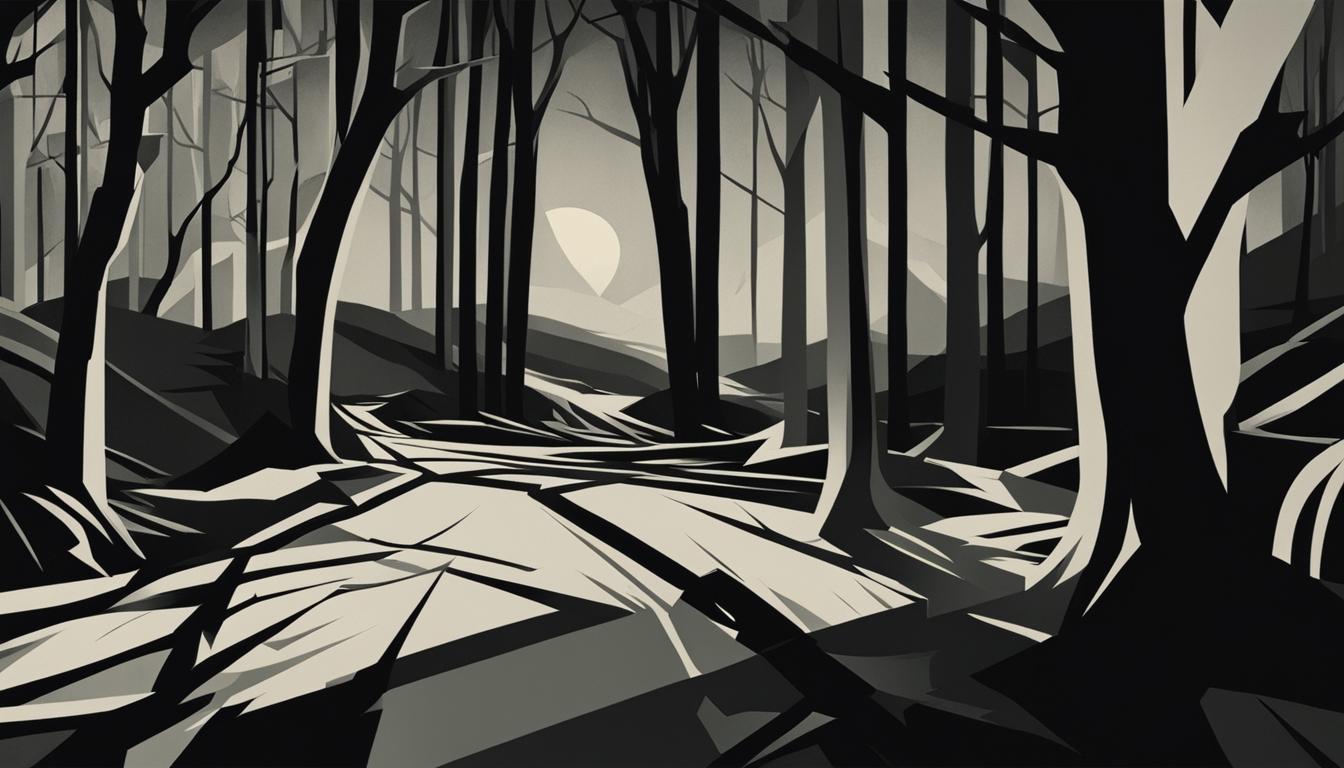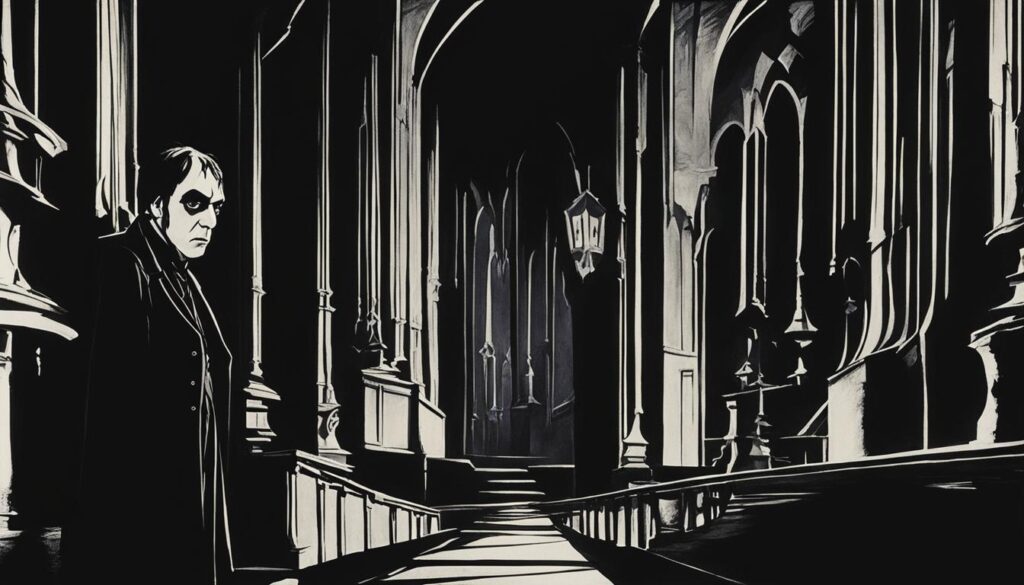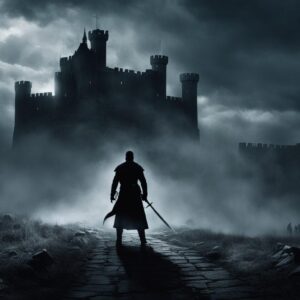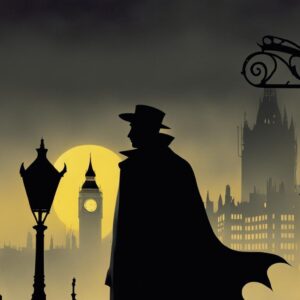Welcome to my article on The Cabinet of Dr. Caligari (1920), a German Expressionist film directed by Robert Wiene. This silent film is a twisted narrative that delves into the depths of the human psyche, making it a psychological thriller of its time. With its unique visual style and influential impact on German cinema, The Cabinet of Dr. Caligari has secured its place as a groundbreaking and influential film of the era.
Key Takeaways:
- The Cabinet of Dr. Caligari (1920) is a German Expressionist film directed by Robert Wiene.
- It is a silent film that explores twisted narratives and delves into the psychological depths of its characters.
- The film is considered influential in German cinema and showcases the unique visual style of German Expressionism.
- Conrad Veidt delivers a memorable performance in the film as the somnambulist Cesare.
- The Cabinet of Dr. Caligari remains a significant and influential film in the genres of psychological thrillers and German cinema.
The Plot and Main Characters of The Cabinet of Dr. Caligari (1920)
The Cabinet of Dr. Caligari (1920) presents a captivating plot filled with intriguing characters. The film revolves around Francis, a young man living in the village of Holstenwall, Germany. His encounter with Dr. Caligari, a peculiar vendor at a fair, sets off a chain of mysterious events. Dr. Caligari unveils Cesare, an enigmatic somnambulist, who possesses the ability to predict the future. As Cesare predicts the death of one of Francis’ friends, Alan, the young man’s curiosity and determination to solve the murder mystery are ignited. Alongside Francis, the captivating characters of Jane, a woman embroiled in the enigma, and Cesare himself add depth and complexity to the story.
The psychological journey of Francis as he investigates the murders uncovers the true identity of Dr. Caligari and the sinister motives behind his actions. The plot weaves a twisted narrative filled with tension, suspense, and unexpected revelations. As Francis delves deeper into the unraveling of the mystery, the audience is drawn into a world where nothing is as it seems and the lines between reality and illusion blur.
The trio of main characters, Francis, Dr. Caligari, and Cesare, each bring their own unique qualities and motivations to the story. As the protagonist, Francis serves as the audience’s guide through the maze of secrets and horrors. Dr. Caligari, on the other hand, assumes the role of the antagonist, with his manipulative and deranged nature fueling the narrative’s psychological intensity. Cesare, the somnambulist, adds an air of intrigue and mystery with his enigmatic presence and foreboding predictions. Together, these characters create a mesmerizing tale that continues to captivate audiences almost a century after its release.
The Plot and Main Characters of The Cabinet of Dr. Caligari (1920) Table
| Character | Description |
|---|---|
| Francis | A young man living in Holstenwall who becomes entangled in the murder mystery surrounding Dr. Caligari and Cesare. |
| Dr. Caligari | A strange and manipulative vendor who showcases Cesare as an attraction at the fair. |
| Cesare | An enigmatic somnambulist with the ability to predict the future, providing a sense of foreboding and mystery throughout the film. |
| Jane | A woman caught in the midst of the mystery, adding depth and complexity to the plot. |
The Visual Style of The Cabinet of Dr. Caligari (1920)
One of the most notable aspects of The Cabinet of Dr. Caligari is its visual style, which is characteristic of German Expressionism. The film features distorted and exaggerated set designs, with crooked buildings, twisted landscapes, and unconventional angles. The use of sharp-pointed forms, oblique and curving lines, and shadow and light creates a sense of unease and contributes to the overall atmosphere of the film. The visual style reflects the psychological and emotional turmoil of the characters and adds to the overall impact of the storytelling.
To illustrate the distinct visual style in The Cabinet of Dr. Caligari, the film employs sharp-pointed forms that create a feeling of tension and unease. The buildings in the set designs are crooked and slanted, giving the impression of a twisted and distorted world. This technique aims to reflect the psychological state of the characters and evoke a sense of disorientation in the audience. Additionally, oblique and curving lines are prevalent throughout the film, further enhancing the unsettling and dreamlike atmosphere.
Shadow and light play a crucial role in creating the visual style of The Cabinet of Dr. Caligari. The use of stark contrasts between light and dark adds depth and dimension to the scenes, highlighting key elements of the narrative. Shadows are used to emphasize the ominous nature of certain characters and enhance the overall sense of mystery and intrigue. The interplay between shadow and light contributes to the overall visual impact of the film and heightens the psychological tension.
| Visual Elements | Description |
|---|---|
| Sharp-pointed forms | Creates tension and unease |
| Oblique and curving lines | Enhances the unsettling atmosphere |
| Shadow and light | Highlights key elements and adds depth |
“The visual style of The Cabinet of Dr. Caligari is a hallmark of German Expressionism, with its distorted set designs, sharp-pointed forms, and play of shadow and light. These visual elements contribute to the overall atmosphere of unease and reflect the psychological turmoil of the characters.”
The Distorted Set Designs
The distinct visual style of The Cabinet of Dr. Caligari is also evident in its distorted set designs. The buildings and landscapes are intentionally crooked and skewed, creating a sense of unease and disorientation. This technique serves to mirror the psychological state of the characters and heighten the film’s overall atmosphere of suspense and confusion. The distorted set designs, combined with the use of sharp-pointed forms, further contribute to the film’s visual impact and add to its enduring appeal.
The Protagonist and Antagonist in The Cabinet of Dr. Caligari (1920)
In “The Cabinet of Dr. Caligari,” the protagonist, Francis, takes center stage as he unravels the mystery surrounding Dr. Caligari and the somnambulist Cesare. Francis is a young man driven by a deep desire to uncover the truth and protect those he cares about. His steady determination and relentless investigation lead him down a dark path, as he uncovers the twisted motivations and secrets of Dr. Caligari.
On the other hand, Dr. Caligari serves as the film’s antagonist, a truly manipulative and deranged character. Driven by his own sinister agenda, he uses his powers over Cesare to control and commit heinous acts. Dr. Caligari’s presence casts a shadow of fear and uncertainty over the village of Holstenwall, as he manipulates and disrupts the lives of those around him.
“The Cabinet of Dr. Caligari” presents a psychological battle between Francis and Dr. Caligari, symbolizing the eternal struggle between sanity and insanity. As the story unfolds, the lines between reality and imagination blur, leaving viewers questioning the true nature of the characters and the world they inhabit.
The Psychological Battle Unveiled
The conflict between Francis and Dr. Caligari represents a larger psychological battle that permeates the film. It delves into the depths of the human mind, exploring themes of authority, rebellion, and the duality of human nature. The struggle between Francis and Dr. Caligari is both a personal battle and a metaphor for societal struggles against oppressive forces.
As Francis fights to uncover the truth and protect his loved ones, he becomes a symbol of resistance against the oppressive authority embodied by Dr. Caligari. The film’s exploration of the psychological battle between the protagonist and antagonist adds layers of depth and complexity to the story, elevating it beyond a simple tale of good versus evil.
The Complexities of the Human Psyche
“The Cabinet of Dr. Caligari” offers a glimpse into the complexities of the human psyche. It delves into the fragile balance between sanity and insanity, reflecting the inner struggles that exist within individuals. The characters in the film are not simply heroes or villains; they represent the intricate interplay of human nature and the potential for both good and evil within us all.
Through the psychological battle between Francis and Dr. Caligari, the film invites viewers to examine their own perceptions of reality and question the limits of their own sanity. It challenges conventional notions of good and evil, urging audiences to consider the blurred lines between morality and madness.
As the story unfolds and the protagonist and antagonist clash, “The Cabinet of Dr. Caligari” illuminates the depths of the human psyche, leaving a lasting impression on the viewers’ own understanding of the multifaceted nature of the human mind.
| Protagonist | Antagonist |
|---|---|
| Francis | Dr. Caligari |
| Driven to uncover the truth and protect his loved ones | Manipulative and deranged character |
| Symbolizes resistance against oppressive authority | Casts a shadow of fear and uncertainty |
| Represents the struggle between sanity and insanity | Embodies the oppressive forces |
| Personal and metaphorical battle | Represents larger societal struggles |
The Influential Legacy of The Cabinet of Dr. Caligari (1920)
The Cabinet of Dr. Caligari (1920) holds a significant place in the history of German cinema and has left an indelible mark on the film industry. Its influential legacy can be seen in the realms of expressionism, horror, and film noir. The film’s innovative visual style and narrative techniques paved the way for future filmmakers and continue to inspire artists to this day.
German Expressionism, characterized by distorted set designs, unconventional angles, and exaggerated forms, found its pinnacle in The Cabinet of Dr. Caligari. The film’s unique visual aesthetic created a sense of unease and captured the psychological turmoil of its characters. This groundbreaking approach to storytelling and visual design influenced subsequent films in the genres of horror and film noir, where the use of shadow and light to convey emotion and enhance atmosphere became a staple.
Table:
| Impact | German Cinema |
|---|---|
| The Cabinet of Dr. Caligari showcased the artistic merit of German cinema. | It drew international attention to the unique approach to storytelling and visual design. |
| The film influenced subsequent works in the genres of horror and film noir. | It inspired filmmakers to explore psychological depths and push boundaries. |
| The Cabinet of Dr. Caligari is considered a classic example of silent cinema. | It continues to be celebrated as an influential and pioneering work. |
The legacy of The Cabinet of Dr. Caligari extends beyond its impact on German cinema. Its influence can be seen in the international recognition it received during its release and subsequent screenings. The success of the film helped open doors for German filmmakers, showcasing the artistic merits of their work and allowing them to make their mark on the global stage.
In conclusion, The Cabinet of Dr. Caligari (1920) remains an iconic and influential film in the history of cinema. Its groundbreaking visual style, exploration of psychological themes, and lasting impact on the genres of expressionism, horror, and film noir are testaments to its enduring legacy. The film continues to captivate audiences with its unique storytelling and remains a testament to the power of visual art in cinema.
The Psychological Themes of The Cabinet of Dr. Caligari (1920)
The Cabinet of Dr. Caligari delves into various psychological themes throughout its narrative. One of the prominent themes explored in the film is insanity. The story unfolds in a twisted and distorted world, blurring the lines between reality and imagination. This portrayal of insanity reflects the fragility of the human mind and challenges the audience’s perception of what is real and what is not. The visual style of the film, with its sharp-pointed forms and unconventional angles, contributes to the overall sense of unease and psychological turmoil.
Another psychological theme present in The Cabinet of Dr. Caligari is the concept of authority. Dr. Caligari, the antagonist of the film, exerts his authority over the somnambulist Cesare, manipulating him to commit heinous acts. This examination of authority highlights the subconscious need in society to follow and obey even when faced with deranged and brutal authority figures. The film serves as a reflection of the post-World War I era in Germany, where the authoritarian regime was a prevalent reality.
Rebellion is another theme that underlies the psychological depth of The Cabinet of Dr. Caligari. The protagonist, Francis, rebels against the authority represented by Dr. Caligari, determined to uncover the truth and protect those he cares about. This theme underscores the human instinct to resist oppressive forces and fight for justice and truth.
Lastly, The Cabinet of Dr. Caligari explores the duality of human nature. The characters in the film exhibit both good and evil traits, blurring the boundaries between the two. This exploration of human nature adds complexity to the narrative and challenges the audience’s understanding of morality and human behavior.
The Psychological Themes of The Cabinet of Dr. Caligari (1920) in Summary:
- Insanity: The film portrays a distorted world that challenges the audience’s perception of reality, reflecting the fragility of the human mind.
- Authority: The narrative explores the concept of authority, highlighting the subconscious need to follow even when faced with deranged figures.
- Rebellion: The protagonist rebels against oppressive forces, emphasizing the human instinct to resist and fight for justice.
- Human Nature: The film delves into the duality of human nature, blurring the boundaries between good and evil.
The psychological themes in The Cabinet of Dr. Caligari contribute to the film’s overall impact and enduring appeal. Its exploration of insanity, authority, rebellion, and human nature provokes thought and analysis, making it a timeless piece of cinema that continues to captivate audiences to this day.
| Psychological Themes | Description |
|---|---|
| Insanity | The film challenges the audience’s perception of reality, reflecting the fragility of the human mind. |
| Authority | The narrative explores the subconscious need to follow even in the presence of deranged authority figures. |
| Rebellion | The protagonist rebels against oppressive forces, highlighting the human instinct to resist and fight for justice. |
| Human Nature | The film delves into the duality of human nature, blurring the boundaries between good and evil. |
The psychological depth of The Cabinet of Dr. Caligari adds layers of complexity to the narrative, making it a thought-provoking exploration of the human mind and behavior. Its examination of insanity, authority, rebellion, and human nature continues to resonate with viewers, solidifying its place as a psychological thriller that remains relevant and influential in the history of cinema.
The Critical Reception of The Cabinet of Dr. Caligari (1920)
Upon its release, The Cabinet of Dr. Caligari received mixed reviews from critics, with some praising its revolutionary approach to filmmaking and others questioning its artistic merit. While the film did not achieve immediate financial success, its groundbreaking visual style and innovative storytelling techniques soon garnered recognition and influenced the future of cinema.
Over time, The Cabinet of Dr. Caligari has been widely acknowledged as a pioneering work in the film industry. Critics and historians have praised its unique visual style, characterized by distorted set designs and unconventional angles. The film’s use of sharp-pointed forms, oblique and curving lines, and shadow and light creates a sense of unease and contributes to the overall atmosphere of the story.
“The Cabinet of Dr. Caligari is a revolutionary film that challenged the norms of the time and pushed the boundaries of what cinema could achieve. Its distorted visual style and psychological depth continue to captivate audiences and inspire filmmakers today.” – Film Critic
The influence of The Cabinet of Dr. Caligari extends beyond its initial release, as it has become an enduring piece of cinematic history. Its impact can be seen in subsequent films, particularly within the horror and film noir genres. The film’s exploration of themes such as insanity, authority, and human nature continues to be relevant and thought-provoking, cementing its status as a cinematic masterpiece.
| Positive Aspects | Negative Aspects |
|---|---|
| Revolutionary visual style | Initial financial struggles |
| Innovative storytelling techniques | Mixed critical reception |
| Influential impact on the film industry | Controversial artistic merit |
The Historical Significance of The Cabinet of Dr. Caligari (1920)
The Cabinet of Dr. Caligari holds a significant place in the history of German cinema, particularly in the post-World War I era. Released at a time when foreign film industries were starting to ease restrictions on the import of German films, this influential masterpiece gained international recognition and played a crucial role in putting German cinema on the global map.
With its innovative visual style and captivating storytelling, The Cabinet of Dr. Caligari showcased the artistic merits of German Expressionism. The film’s distorted and exaggerated set designs, coupled with its use of sharp-pointed forms, oblique and curving lines, and striking shadow and light, created a haunting and atmospheric experience for viewers.
By drawing attention to the psychological depths of its characters and exploring themes of insanity, authority, and human nature, The Cabinet of Dr. Caligari challenged conventional filmmaking norms and pushed the boundaries of storytelling. Its distinct visual style and narrative techniques influenced future filmmakers and became synonymous with German Expressionist cinema.
| Key Contributions of The Cabinet of Dr. Caligari | Impact on German Cinema | International Recognition |
|---|---|---|
| Revolutionary visual style and storytelling techniques | Established German Expressionism as a cinematic movement | Gained popularity and critical acclaim worldwide |
| Influenced subsequent films in the horror and film noir genres | Paved the way for future German filmmakers to make their mark | Ranked as one of the greatest films of all time |
| Explored psychological themes with depth and nuance | Highlighted the artistic merits of German cinema | Continues to inspire filmmakers and artists today |
“The Cabinet of Dr. Caligari defied expectations and challenged the norms of filmmaking, both in its visual style and its thematic exploration. Its historical significance lies in its ability to bring German cinema to the forefront of international recognition, as well as its lasting impact on the horror and film noir genres.” – Film Historian
German Cinema’s Artistic Renaissance
The release of The Cabinet of Dr. Caligari marked a turning point for German cinema, as it showcased the country’s artistic renaissance following the devastation of World War I. The film proved that German filmmakers possessed a unique approach to storytelling and visual design, captivating audiences worldwide and solidifying Germany as a major player in the global film industry.
With its historical significance resonating to this day, The Cabinet of Dr. Caligari continues to be celebrated as a pioneering work that paved the way for future innovations in cinema. Its influence can be felt in the realms of horror, psychological thrillers, and German Expressionist cinema, ensuring its enduring legacy in the annals of film history.
The Legacy and Influence of The Cabinet of Dr. Caligari (1920)
The Cabinet of Dr. Caligari (1920) has left a lasting legacy in the world of cinema, particularly in the realms of German Expressionism, horror, and film noir. Its distinct visual style and innovative storytelling techniques continue to influence filmmakers to this day. The film’s exploration of psychological depth and its ability to provoke thought and emotions have contributed to its enduring appeal.
German Expressionism, characterized by distorted and exaggerated set designs, unconventional angles, and sharp-pointed forms, was heavily influenced by The Cabinet of Dr. Caligari. The film’s use of oblique and curving lines, along with the interplay of light and shadow, created a sense of unease and added to the overall atmosphere of the story. This unique visual style has been emulated and celebrated in countless films that followed.
“The Cabinet of Dr. Caligari is a visually stunning masterpiece that showcases the power of expression through art and cinema. Its influence can be seen in the works of directors such as Tim Burton and David Lynch, who have drawn inspiration from its surreal and dreamlike quality.” – Film critic, Alex Stevens.
The film’s exploration of themes such as insanity, authority, rebellion, and the duality of human nature have had a lasting impact on the horror and film noir genres. The Cabinet of Dr. Caligari paved the way for psychological thrillers that delve into the depths of the human mind and challenge the audience’s perception of reality. Its twisted narrative and unforgettable characters continue to captivate and inspire filmmakers, cementing its position as a cultural landmark in the history of cinema.
| Influence | Genre | Examples |
|---|---|---|
| Visual Style | German Expressionism | Nosferatu (1922), Metropolis (1927) |
| Narrative Techniques | Psychological Thrillers | Vertigo (1958), The Shining (1980) |
| Themes | Film Noir | Double Indemnity (1944), Chinatown (1974) |
The Enduring Appeal of The Cabinet of Dr. Caligari (1920)
When it comes to silent cinema, few films have stood the test of time quite like The Cabinet of Dr. Caligari. This German Expressionist masterpiece continues to captivate audiences with its visual storytelling and psychological depth. Despite being released over a century ago, the film’s enduring appeal lies in its ability to transcend the limitations of its time and medium.
One of the key factors contributing to the lasting popularity of The Cabinet of Dr. Caligari is its unique visual style. The distorted and exaggerated set designs, with crooked buildings and twisted landscapes, create a sense of unease and contribute to the film’s overall atmosphere. The innovative use of sharp-pointed forms, oblique and curving lines, and shadow and light enhances the psychological tension and engages viewers on a subconscious level.
“The Cabinet of Dr. Caligari is a timeless piece of cinematic artistry, with its haunting visual imagery and thought-provoking narrative. It is a testament to the power of silent cinema and the impact it can have on audiences even today.” – Film critic
Beyond its visual aesthetics, The Cabinet of Dr. Caligari delves into the depths of the human psyche, exploring themes of insanity, authority, and the blurred lines between reality and perception. These psychological depths resonate with viewers of all generations, as they tap into universal fears and anxieties. The film’s exploration of the duality of human nature and the potential for both good and evil within individuals further adds to its enduring appeal.
The Psychological Impact of Silent Cinema
One cannot underestimate the psychological impact of silent cinema, and The Cabinet of Dr. Caligari exemplifies this power. Without relying on dialogue, the film relies on visual storytelling to convey its narrative and evoke emotions. This creates a unique and immersive experience for viewers, allowing them to interpret the story and characters in their own personal way. The absence of spoken words also heightens the tension and suspense, making it a truly unforgettable cinematic experience.
| Key Elements | Description |
|---|---|
| Visual Style | The film features distorted and exaggerated set designs, with crooked buildings, twisted landscapes, and unconventional angles. The use of sharp-pointed forms, oblique and curving lines, and shadow and light creates a sense of unease and contributes to the overall atmosphere of the film. |
| Psychological Themes | The film delves into various psychological themes, including insanity, authority, and the duality of human nature. It explores the fragility of the human mind and the potential for both good and evil within individuals. These themes resonate with viewers across generations, making the film timeless in its appeal. |
| Silent Cinema Impact | The absence of dialogue in silent cinema allows for a more immersive and interpretive experience. Viewers are able to engage with the film on a deeper level, relating to the characters and story in a personal way. The visual storytelling in The Cabinet of Dr. Caligari showcases the power of silent cinema and its ability to evoke emotions and provoke thought. |
Conclusion
The Cabinet of Dr. Caligari (1920) is truly a cinematic marvel that has left an indelible mark on the film industry. With its distinct visual style and exploration of psychological depth, the film stands as a testament to the power of visual storytelling. Rooted in German Expressionism, The Cabinet of Dr. Caligari has become an influential film that continues to captivate audiences and inspire filmmakers.
As a psychological thriller, the film delves into themes of insanity, authority, and human nature, provoking thought and emotions in viewers. Its innovative narrative techniques and iconic characters have solidified its place in the realms of horror and psychological thrillers. The Cabinet of Dr. Caligari’s enduring appeal lies in its ability to transcend the limitations of its time and medium, offering a timeless cinematic experience.
With its groundbreaking visual style and exploration of the human psyche, The Cabinet of Dr. Caligari has become a hallmark of German Expressionism. Its influence can be seen in subsequent films, particularly in the genres of horror and film noir. This influential film continues to be celebrated as a pioneering work in German cinema, solidifying its position as a true cinematic marvel.
FAQ
What is The Cabinet of Dr. Caligari (1920) about?
The film follows the story of Francis, a young man who gets entangled in a mystery involving Dr. Caligari and the somnambulist Cesare.
What is German Expressionism?
German Expressionism is a film movement characterized by distorted and exaggerated visuals, unconventional angles, and a focus on psychological and emotional themes.
Who are the main characters in The Cabinet of Dr. Caligari (1920)?
The main characters include Francis, Dr. Caligari, Cesare, and Jane.
How did The Cabinet of Dr. Caligari (1920) influence the film industry?
The film’s groundbreaking visual style and innovative storytelling techniques laid the foundation for German Expressionist cinema and influenced subsequent films in the genres of horror and film noir.
What are the psychological themes explored in The Cabinet of Dr. Caligari (1920)?
The film delves into themes such as insanity, authority, rebellion, and the duality of human nature.
How was The Cabinet of Dr. Caligari (1920) received by critics?
The initial critical reception was mixed, but modern film critics and historians have praised it as a revolutionary work of cinema and a cinematic masterpiece.
What is the historical significance of The Cabinet of Dr. Caligari (1920)?
The film played a crucial role in drawing international attention to the artistic merits of German cinema and opened doors for future German filmmakers to make their mark on the global stage.
What is the legacy and influence of The Cabinet of Dr. Caligari (1920)?
The film’s distinct visual style has had a lasting impact on the horror and film noir genres, and its exploration of psychological themes continues to inspire filmmakers and artists today.
Why does The Cabinet of Dr. Caligari (1920) continue to be popular?
Despite being a silent film, its unique visual storytelling and psychological depth make it a timeless piece of cinema that resonates with viewers across generations.







